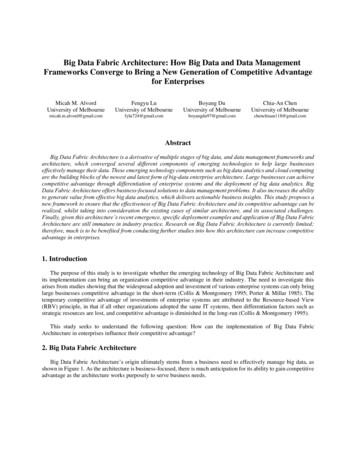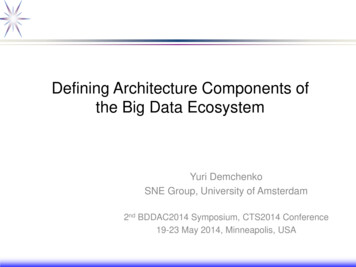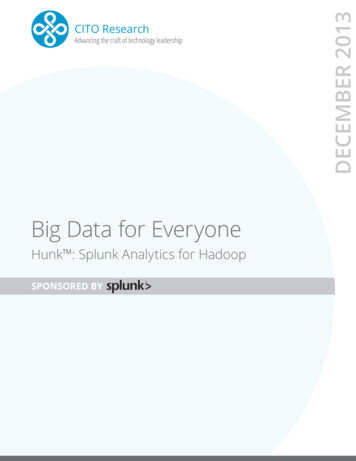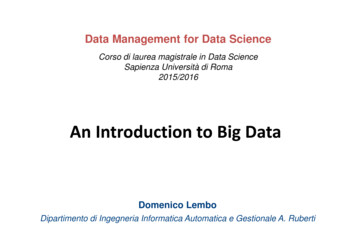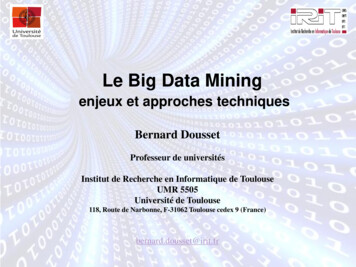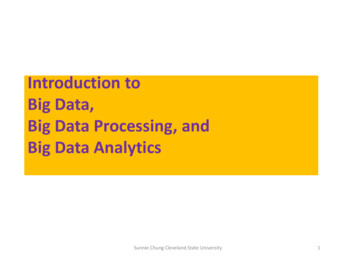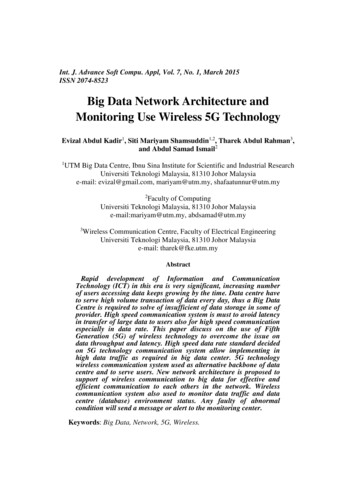
Transcription
Int. J. Advance Soft Compu. Appl, Vol. 7, No. 1, March 2015ISSN 2074-8523Big Data Network Architecture andMonitoring Use Wireless 5G TechnologyEvizal Abdul Kadir1, Siti Mariyam Shamsuddin1,2, Tharek Abdul Rahman3,and Abdul Samad Ismail21UTM Big Data Centre, Ibnu Sina Institute for Scientific and Industrial ResearchUniversiti Teknologi Malaysia, 81310 Johor Malaysiae-mail: evizal@gmail.com, mariyam@utm.my, shafaatunnur@utm.my2Faculty of ComputingUniversiti Teknologi Malaysia, 81310 Johor Malaysiae-mail:mariyam@utm.my, abdsamad@utm.my3Wireless Communication Centre, Faculty of Electrical EngineeringUniversiti Teknologi Malaysia, 81310 Johor Malaysiae-mail: tharek@fke.utm.myAbstractRapid development of Information and CommunicationTechnology (ICT) in this era is very significant, increasing numberof users accessing data keeps growing by the time. Data centre haveto serve high volume transaction of data every day, thus a Big DataCentre is required to solve of insufficient of data storage in some ofprovider. High speed communication system is must to avoid latencyin transfer of large data to users also for high speed communicationespecially in data rate. This paper discuss on the use of FifthGeneration (5G) of wireless technology to overcome the issue ondata throughput and latency. High speed data rate standard decidedon 5G technology communication system allow implementing inhigh data traffic as required in big data center. 5G technologywireless communication system used as alternative backbone of datacentre and to serve users. New network architecture is proposed tosupport of wireless communication to big data for effective andefficient communication to each others in the network. Wirelesscommunication system also used to monitor data traffic and datacentre (database) environment status. Any faulty of abnormalcondition will send a message or alert to the monitoring center.Keywords: Big Data, Network, 5G, Wireless.
Evizal Abdul Kadir et al.12IntroductionBig Data in Information and Communication Technology (ICT) is data collectionin large number and complex data transfer / transaction that need a good datamanagement system or application to process of those data sets because currentdata management have difficulties to handle it. Some challengers for datacollection such as data storage and need large database capacity, data capture andsharing that required high speed infrastructure system, data visual and analysisrequired good management system tools to do that. With high volume andnumbers of data need to collect and large number data traffic, a new method ofinformation system is required to process of that ability to enhancement decisionand management system also optimization performance.Billions number of data transaction and streams coming from devices worldwide,one of the challenges for the current data management to serve without any lossesand low throughput also latency. Although, after enabling and integration of cloudmanagement system still having difficulties to serve all the data streams andtransaction. Cloud based Big Database and Data centre techniques offer somepromise to overcome issues mentions above.Mobile of people with carrying device such as smart phone or tablet is extendingof Internet of Things (IoT), everyone has their own unique IP/IPs address withhold device. The future of IoT is to manage devices carrying by people around theworld with unique IP as hub and interface to others devices. Billions number ofdevices with IoT has capability to sense, communicate and detect that allowefficient communication and data collection thru the device. Introduction ofInternet Protocol version 6 (IPv6) and low power wireless network would able todo sensing and communication through devices. With the IPv6 has billionsnumber of unique IPs for device and sensor that apply for house application suchas monitoring of cameras, manage assets, house equipments controlling andsecurity application.Fifth Generation (5G) is promising technology to use for future development intelecommunication infrastructure. Currently, the use of radio frequency spectrumis in wide area, information system, industry, medical, education and so on thanthe spectrum a bit mess. By 2020 is estimate that 50 billion devices will beconnected to the internet, so alternative of the use spectrum for connections ofdevices to internet need to be attention else system unable to serve of highdemand. The large number of devices and machines connected to internet will bedue to a boom inanimate object using the 5G network as known as the Internet ofThings (IoT).In this paper, discuss more on the use of 5G technology and wirelesscommunication system to accommodate large number of devices and capacity forBig Data Centre (BDC). The promising technology to use 5G technology asalternative system in backbone and framework for Big Data infrastructure,
3Big Data Network Architecturebecause of standard sets in 5G technology able to running in high speed Gigabitsdata connection. High speed data transfer and connection is required in Big DataCentre to serve large number of clients and high volume of data storage, elsemany issues facing up and also slow system will happen.2Literature ReviewIncreasing number of devices and user accessing internet gives impact to thenumbers of data, whether stored into database or communication data betweenusers. Thus, very high speed technology to serves those devices is a must else lowspeed of communication and delay occur. Several papers discussed on the use ofwireless technology into data communication network and architecture scenarios.Proposing of a comprehensive framework for empowering SONs to big data andaddress the requirements of 5G technology as discussed in [2], this frameworkcharacterize big data in the context of future mobile networks, identifying itssources and future utilities. Demonstrate of the spatial big data can play a key rolein many emerging wireless networking applications discussed in [3] argue thatspatial and spatiotemporal problems have their own very distinct role in the bigdata context compared to the commonly considered relational problems. Threemajor application scenarios for spatial big data, each imposing specific design andresearch challenges. Then present our work on developing highly scalable parallelprocessing frameworks for spatial data in the Hadoop framework using the MapReduce computational model.Traffic monitoring system and analysis for large-scale networks based on Hadoopas elaborated in [4, 5] an open-source distributed computing platform for big dataprocessing on commodity hardware. The system has been deployed in the corenetwork of a large cellular network. In [6] discusses the challenges andrequirements in the design of 5G wireless networks for the big data center.Discussion on how cloud technologies and flexible functionality assignment inradio access networks enable network densification and centralized operation ofthe radio access network over heterogeneous backhaul networks. Article alsodescribes the fundamental concepts, how to evolve the 3GPP LTE architecture,and outlines the expected benefits.Proposing a solution to cope with the tremendous amount of data to analyze forsecurity monitoring perspectives based on security of local enterprise networksand an overlay network construction scheme based on node location in physicalnetwork, a distributed task allocation scheme using overlay network technologyalso Empowered Self Organized Networks on Big Data as discussed in [7-9]. Acase studies of real-world big data applications that are empowered bynetworking, highlighting interesting and promising future research directionsincluding network highway and introduces a design methodology of an overlaybased parallel processing architecture based on integration of overlay and physicalnetworks presented in [10, 11]. Review on application of Internet of Things (IoT)
Evizal Abdul Kadir et al.4into industrial and key enabling technologies, major IoT applications in industries,also identifies research trends and challenges. Trend on future of internet insupporting new applications, efficient resource utilization, and continuousevolvement discussed in [12, 13].Propose a potential cellular architecture that separates indoor and outdoorscenarios, and discuss various promising technologies for 5G wirelesscommunication systems, such as massive MIMO, energy-efficientcommunications, cognitive radio networks, and visible light communications [14].Future challenges facing these potential technologies and identifies severalemerging technologies which will change and define the future generations oftelecommunication standards are discussed in [15, 16]. Fifth generation (5G)cellular networks describes five technologies that could lead to both architecturaland component disruptive design changes, ideas for each technology aredescribed, along with their potential impact on 5G and the research challenges inwireless for Big Data Network Architecture. Expected to achieve high speed 5Gbackbone and used of Node C as a new communication entity is defined toconverge the existing ancestral base stations as discussed in [17, 18].3Big Data EraBig data is being generated by everything around us at all times, any informationcomes with the information and must have number of data then need to keep orstored in database. Various types of data come from many source of informationsuch as sensor, machine, social network, message or mail and voice or video.Those data can be text, voice or video type then in term of format can bestructured, unstructured or semi structured. Big data is changing the way of peopleand organizations to think for future trend and technology also work together.Figure 1 show how a Big Data architecture framework illustrated, data sourcescomes from multi input and various types, then data stream analysis follow bydata cluster and data search & query.Definition of Big Data according the need of industry consists of severalparameters such as; Volume, many numbers of factors that contribute to the increase in datavolume. Everyday industry keep produce thousand even million numbers oftransaction data then stored through the years. Increasing amounts of sensor inindustry, additional member of social network and message or emailtransaction everyday collected huge number of data. Previously, excessivenumbers of data in volume make issue on storage capacity. Emerging plan forthe storage and decreasing technique for file including how to determinerelevance and usable within large data volumes also how to use analyticstechnique to create value of data in relevant. Velocity, data stream is in unpredicted speed and need to monitor timely. For
5Big Data Network Architectureexample, RFID tags, sensors, and transducer are parameters of source of datahave to communicate in real-time. Highly response of data and quick reactionto meet data velocity is challenging for Big Data backbone. Variety, nowadays sources of data comes in many types of format andstructured of numeric data in conventional database. Unstructured format ofdata such as text, documents, audio, video, email and social media transaction.Technique to managing, governing and merging of different types of data issomething needs to do a new technique to handle it. Variability, additional to the increasing velocities and varieties of big data,flows of data maybe highly inconsistent compare to period of peaks. This ishappen in and something trending in social media network. Every day,seasonal and event-triggered peak data loads can be challenging to manage andeven more so with unstructured data involved. Complexity, today's data comes from several of sources. Then still very hard toundertaking to the network link, need to match, transform data and cleanseform data across systems. However, it is very important to connect and linkageof data in quick response in correlate relationships, hierarchies and multipledata network.Fig. 1 Big Data Analytics Architecture FrameworkSeveral sources of information as mention in above become raw data to datacenter and in huge numbers, all of data then will send to Big Data Staging forprocessing then only useful or valuable data that need by user will select anddelivery to user. This process called Big Data Staging because in this stage bignumber of data classified based on the structured and types of data. Figure 2shows a block diagram and process of Big Data Staging to classify of data.Staging process is required in order to improve efficiency and faster the process
Evizal Abdul Kadir et al.6else big number of data will effected to the processing time and accuracy.Fig. 2 Big Data Staging Process4Fifth Generation (5G) TechnologyHigh speed data communication network normally build in wired architecturesuch as cable or fiber optic, wireless technology thru radio signal system isalternative network for data communication beside those wired system. Radiocommunication has evolution started from First Generation (1G) mobile / radiocommunication which analog system and continue for the Second and ThirdGeneration (2G/3G). Then in year 2010 Fourth Generation (4G) of mobilecommunication introduced to make faster in term of speed and high capacity ofdata communication.Fifth Generation (5G) wireless or mobile networks have a capability to supportcommunication in high speed and capacity. The connections expected ability tosupport for at least 100Bn devices at a data rate of 10Gbps per user with lowlatency and faster response times. Implementation and deployment of 5Gtechnology is expected in 2020 because currently in process of research anddevelopment also standardization. The use of 5G networks expected will risebetween 2020 and 2030 once after deployment. Anyhow, 5G networks will belayered upon the existing wireless technologies such as Global System for MobileCommunication (GSM) and Wireless Fidelity (Wi-Fi) also radio accesstechnologies. Figure 3 shows a mobile communication evolution started from 1Guntil now is 5G [15].
7Big Data Network ArchitectureFig. 3 Mobile Communication Evolution 1G to 5G [1]5G wireless network is future technology that can implement in real fortransformation of the world population into an end-to-end globally. Data analyticscan be built on the cloud computing that drive business prospects and enrich userrequirement. 5G technology would be challenging and crucial in realizing “zerodistance” connectivity between users and devices across globally. With significanttechnological implemented and advance incorporate in telecom provider wouldgive the customer requirement and need to a different level. 5G technology is ableas role model for future of smart city planning and implementation for very highspeed data network for million numbers of user and devices.There are several advantages of implementing 5G for communication either voiceand video or data, although 5G technology is expected to solve some issue thatcurrently facing but there are some challenges need to be addressed inimplementation also deployment this technology. Some factors involve such asthe capability of the wireless networks infrastructure to support massive capacityand connectivity, support diverse set of services and efficiently of the useavailable spectrum need. More than that advanced breakthroughs in waveformrelated technologies have to be accomplished in order to develop 5G to perfection.Figure 4 shows 5G technology advantages in five categories.Fastresponsetime, lowjitter,latencyand delayand y wideareacoverageGigabit dataMorerates, High- connectedqualitydevices,coverage, deep s5G TECHNOLOGYFig. 4 Five Categories Advantages of 5G TechnologyFifth generation standard for communication especially for wireless network alsoinvolved in Wireless Fidelity (Wi-Fi), evolution of Wi-Fi technology started sinceyear 1997, which standardize by IEEE 802.11 that ability for data rate maximum2 Mbps, along the time improvement of speed continue and the latest standard isin Fourth Generation that set to maximum data rate up to 600 Mbps. Nowadays,preparation for Wi-Fi in 5G standard expected to achieve very high speed data
Evizal Abdul Kadir et al.8rate in Gigabits. With the capabilities 100 times faster and lesser latency alsoenhanced battery life compared to 4G, 5G is going to be the next promisingtechnology.Fig. 5 Evolution of 5G Wi-Fi Standard5Big Data Network in 5G TechnologyToday, with tremendous increasing number of devices such as sensor, smartphone, gadget, tablet and machines, all those devices has big size of message/datato be send or receive thus high capacity of network infrastructure is required tocover that transaction else traffic delay and latency occur. The enormous volumeand number with complexity of data that is now being collected by sources to besend to the database or respective user. Investigation in a Big Data Network inorder to optimize this network is urgently needed because by the time volume oftraffic and transaction keep increasing. Conventional wired network like fiberoptic and twisted cable as currently used for backbone to connect between serveror data center is limited for some of application. For next decade by increasinghuge number of devices need to connect to internet then current infrastructurepredictive unable to serve its. Thus, alternatively technology or infrastructure tohandle high volume of traffic is required; one of the technologies is 5G wirelesscommunication. The other hand, use of wireless communication as backbone isrelated to the devices use by user is more on mobile that need wireless network.Figure 6 shows how illustrated of 5G wireless network infrastructure looks withhigh capacity of network link in Gigabits [1].Fig. 6 Illustrated of 5G Wireless Infrastructure [1]
9Big Data Network Architecture5G technology is considered as a key factor to the Internet of Things (IoT), thenext era expected tying to connect to the internet of anything include peoples.Billions number of sensors will be built and connect into security systems,appliances, health monitors, door locks, cars and wearable’s from smart watches.A survey and analyst from firm Gartner predicts the number of networked devicesconnected to the internet will rapid increasing from about 5 billion in year 2015 to25 billion by year 2020 [19]. In 5G networks, the speed will be about 66 timesmore faster compare than 4G network. That speed opens up intriguing newcapabilities for self-driving of cars can make time-critical decisions. Videoconference will make us feel like meeting in the same room without any delay.Cities are able to monitor traffic congestion remotely, pollution levels, CCTVmonitoring and parking information then feed all that information to your houseor smart car on the road in real time. Furthermore, download speeds shouldincrease from current 4G network with maximum peak is 150 Mbps to at least 10Gbps in 5G network.To deliver 5G network, a carriers will need to support network infrastructurecapacity between mobile devices and the big antennas to get service (called basestations). Carriers will also push base stations installed more closely with in a fewhundred meters to improve the services of mobile devices. Today'stelecommunication provider operated to communicate at low frequency with 100MHz to 3 GHz, for the next 5G network operated in higher frequency bands willbe required. But radio waves at higher frequencies are quite harder to transmitover longer distances or if buildings and walls are blocking. Several newtechniques to compensate, carriers will rely on advanced antenna technologies.These include of massive MIMO (multiple-input multiple-output) antennas, whichsend many radio signals in parallel, and beam forming, which focuses radioenergy in a specific direction. Figure 7 shows how a wireless access is able tocommunicate inter-network for the wireless/access solutions [1].Fig. 7 Scenarios of 5G Wireless Access Network [1]
Evizal Abdul Kadir et al.10Currently, business models are influenced by the availability of internet andnetworking capabilities. Organizations or company are deploying moresophisticated networking equipment and technologies to enhance connectivityacross the business spectrum. Connectivity is a key to quench demandingcustomer, there is huge market potential for technologies such as 5G that hasconnectivity powers several notches greater than the current existing networktechnologies. Figure 8 an example of scenario 5G technology in accessingnetwork starting from user devices and send the data to a big data center.Fig. 8 Scenario of 5G Wireless Access Network6WIRELESS MONITORING FOR BIG DATACENTREData center is a key point in a company, institution or service provider, data centeris to keep all the information or stored all transaction that some time need to queryaccording to the need. Thus, system stability and maximum performance of a datacenter is a must to gives better service to client or company. Installation of a datacenter sometime is not in the area of company running, these can be runningoutside city or rural area, or even in others countries or continental, because of thedistance then a monitoring system is required to monitor activities and gives alertif something is happen to the data center. Many parameters in a datacenter roomneed to continuously monitoring in order to prevent any incident happen, thoseparameters such as environment, room temperature, power line quality, smoke
11Big Data Network Architecturedetection, and others that related to the performance in data system. Figure 11shows an illustrated how monitoring in a data center room, including assetmonitoring to prevent stolen.Fig. 11 Monitoring in a Data Center RoomSince wireless sensor technology has been deployed in a commercial application,implementation to monitor parameters remotely made efficiency either cost ortechnology used. Identification found efficiency measurement used to reduce thedata center cooling load average by 48%, reducing from total data center powerusage by 17% [20]. Wireless sensor network systems also eliminate some of thekey logistical issues in installation of wiring to connect to every sensor in datacenter room. The used of wireless sensor network made easy in installation ormaintenance also to expandable or relocation in future, because of this systemprovide flexibility then become growth in any application beside data center room.Another thing is by wireless monitoring made user friendly to do monitoring inalmost any place and anytime without need to connect or come to the controlstation.Besides monitoring of rooms environment and others physical status related to thedatabase system in server, switch, router and backup power, wireless monitoringis required to check in software side. Software performance and load capacity isneed to regular monitor in order to give good service and performance in a datacenter. Some parameters in software normally required to check regulatory suchas: Database capacity System performance
Evizal Abdul Kadir et al.12 Traffic status Network status to other data center Network capacity Data rate to user Alarm indicator for hardware monitoring User statusBig data is a system build to handle high volume of data required to stored, a bigdatabase (data center) is part of big data system. With high traffic and hugenumber of data transaction everyday even some application serve thousands ormillions of data then a data center have to ready in serving to data center. Thus, agood monitoring system is required to give alert if anything happens in order tosolve within minimum of time. Wireless monitoring system as mention early ispart of big data center to handle by remotely, especially for the long distance datacenter. In a big data system normally data storage setup in several places to handlethe user according to the countries or region and also as backup data if any casehappen in one of the data center, network and interconnection to those data centerby wirelessly is need to manage of the data center.7CONCLUSIONThe use of 5G technology application in Big Data Center network architecture asdiscussed give better efficiency and optimum performance to the devices. Datacenter as database for data stored and query for the user need perform in goodnetwork, increasing number of devices significantly every month or even everyday, thus support for the infrastructure to gives high data rate and services isrequired else system performance and bad services happen. Data centermonitoring is required in order to check status and monitor condition in a databasesystem, some parameters normally monitored in data base such as environment,temperature, power supply, etc. Beside environment, software side also needs tomonitor to check the performance and services capacity. Several monitoringtechnique can be used in data center, but nowadays most popular is wirelessmonitoring system because of the advantages this technology.ACKNOWLEDGEMENTSThis work is partially supported by The Flagship Research Grant Scheme(Q.J130000.2428.02G50; Q.J130000.2428.02G38 and Q.J130000.2428.03G17).The authors would like to thanks Research Management Centre (RMC),Universiti Teknologi Malaysia (UTM) for the support in R & D.
13Big Data Network ArchitectureReferences[1] Ericsson, "5G for the networked society beyond 2020," Mobile WorldCongress 2013, February 2013.[2] A. Imran and A. Zoha, "Challenges in 5G: how to empower SON with bigdata for enabling 5G," Network, IEEE, vol. 28, pp. 27-33, 2014.[3] C. Jardak, et al., "Spatial big data and wireless networks: experiences,applications, and research challenges," Network, IEEE, vol. 28, pp. 26-31,2014.[4] L. Jun, et al., "Monitoring and analyzing big traffic data of a large-scalecellular network with Hadoop," Network, IEEE, vol. 28, pp. 32-39, 2014.[5] H. J. Mikyoung Lee, and Minhee Cho, "On a Hadoop-based Analytics ServiceSystem," International Journal Advance Soft Computing Applications, vol. 7No.1, pp. 1-8, 2015.[6] P. Rost, et al., "Cloud technologies for flexible 5G radio access networks,"Communications Magazine, IEEE, vol. 52, pp. 68-76, 2014.[7] S. Marchal, et al., "A Big Data Architecture for Large Scale SecurityMonitoring," in Big Data (BigData Congress), 2014 IEEE InternationalCongress on, 2014, pp. 56-63.[8] K. Suto, et al., "An Overlay-Based Data Mining Architecture Tolerant toPhysical Network Disruptions," Emerging Topics in Computing, IEEETransactions on, vol. 2, pp. 292-301, 2014.[9] N. Baldo, et al., "Big Data Empowered Self Organized Networks," inEuropean Wireless 2014; 20th European Wireless Conference; Proceedingsof, 2014, pp. 1-8.[10]Y. Xiaomeng, et al., "Building a network highway for big data: architectureand challenges," Network, IEEE, vol. 28, pp. 5-13, 2014.[11]K. Suto, et al., "Toward integrating overlay and physical networks for robustparallel processing architecture," Network, IEEE, vol. 28, pp. 40-45, 2014.[12]Y. Hao, et al., "Big data: transforming the design philosophy of futureinternet," Network, IEEE, vol. 28, pp. 14-19, 2014.[13]X. Li Da, et al., "Internet of Things in Industries: A Survey," IndustrialInformatics, IEEE Transactions on, vol. 10, pp. 2233-2243, 2014.[14]S. M. S. Evizal Abdul Kadir, Eko Supriyanto Tharek Abd Rahman, SharulKamal Abdul Rahim and Sri Listia Rosa, "Multi Bands Antenna for WirelessCommunication and Mobile System," International Journal of Circuits,System and Signal Processing, vol. 8, pp. 563-568, 2014.
Evizal Abdul Kadir et al.14[15]W. Cheng-Xiang, et al., "Cellular architecture and key technologies for 5Gwireless communication networks," Communications Magazine, IEEE, vol. 52,pp. 122-130, 2014.[16]C. Woon Hau, et al., "Emerging technologies and research challenges for 5Gwireless networks," Wireless Communications, IEEE, vol. 21, pp. 106-112,2014.[17]F. Boccardi, et al., "Five disruptive technology directions for 5G,"Communications Magazine, IEEE, vol. 52, pp. 74-80, 2014.[18]M. Peng, et al., "System architecture and key technologies for 5Gheterogeneous cloud radio access networks," Network, IEEE, vol. 29, pp. 6-14,2015.[19]B. Commision, "The State of Broadband 2014 : Broadband for All,"International Telecommunication Union, vol. Geneva, September 2014.[20]R. M. a. W. Tschudi, "Wireless Sensor Network for Improving the EnergyEfficiency of Data Centers," Lawrence!Berkeley!National!Laboratory, 2012.
Big Data Network Architecture and Monitoring Use Wireless 5G Technology Evizal Abdul Kadir 1, Siti Mariyam Shamsuddin 1,2, Tharek Abdul Rahman 3, . 5 Big Data Network Architecture example, RFID tags, sensors, and transducer are parameters of source of data have to communicate in real-time. Highly response of data and quick reaction .

